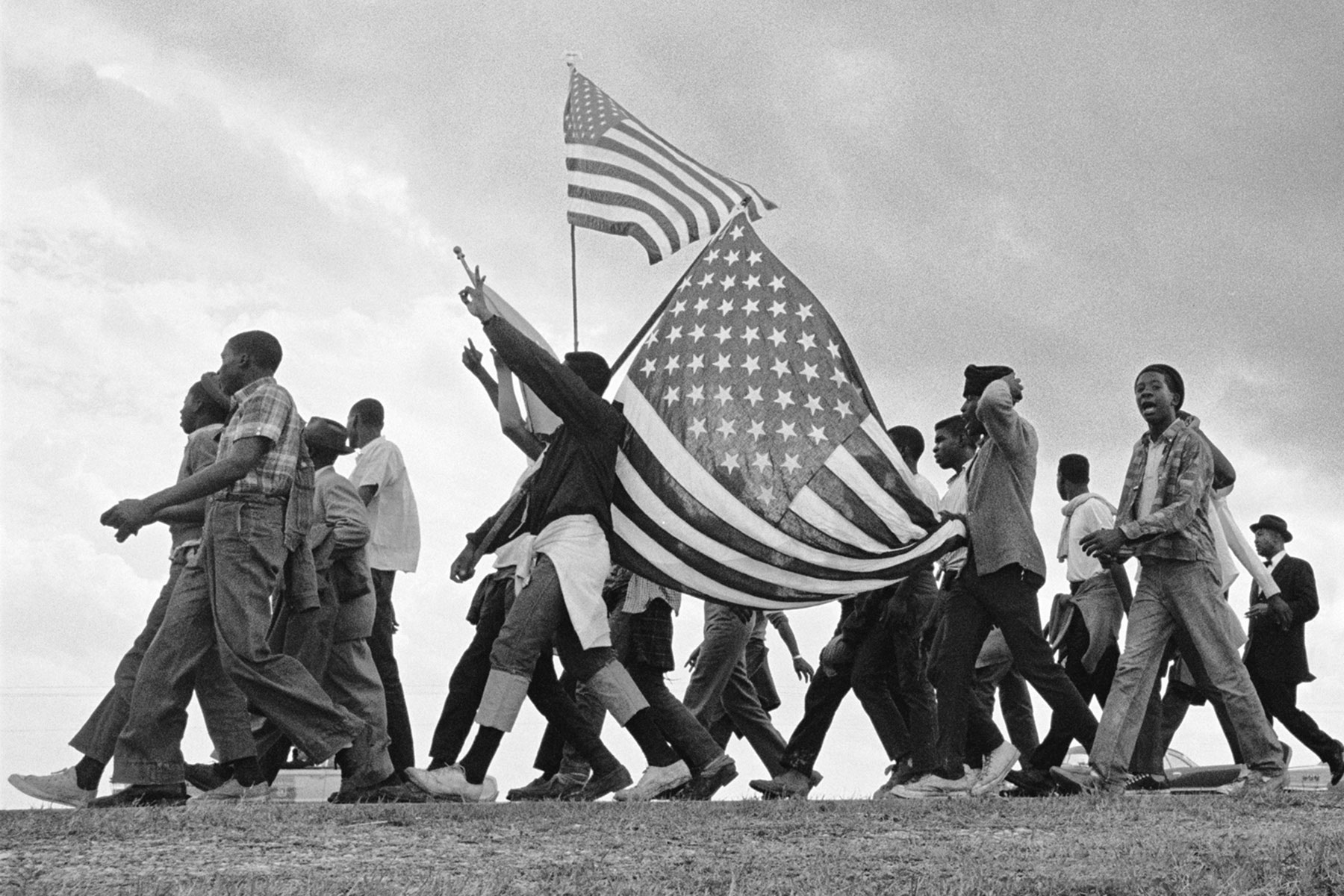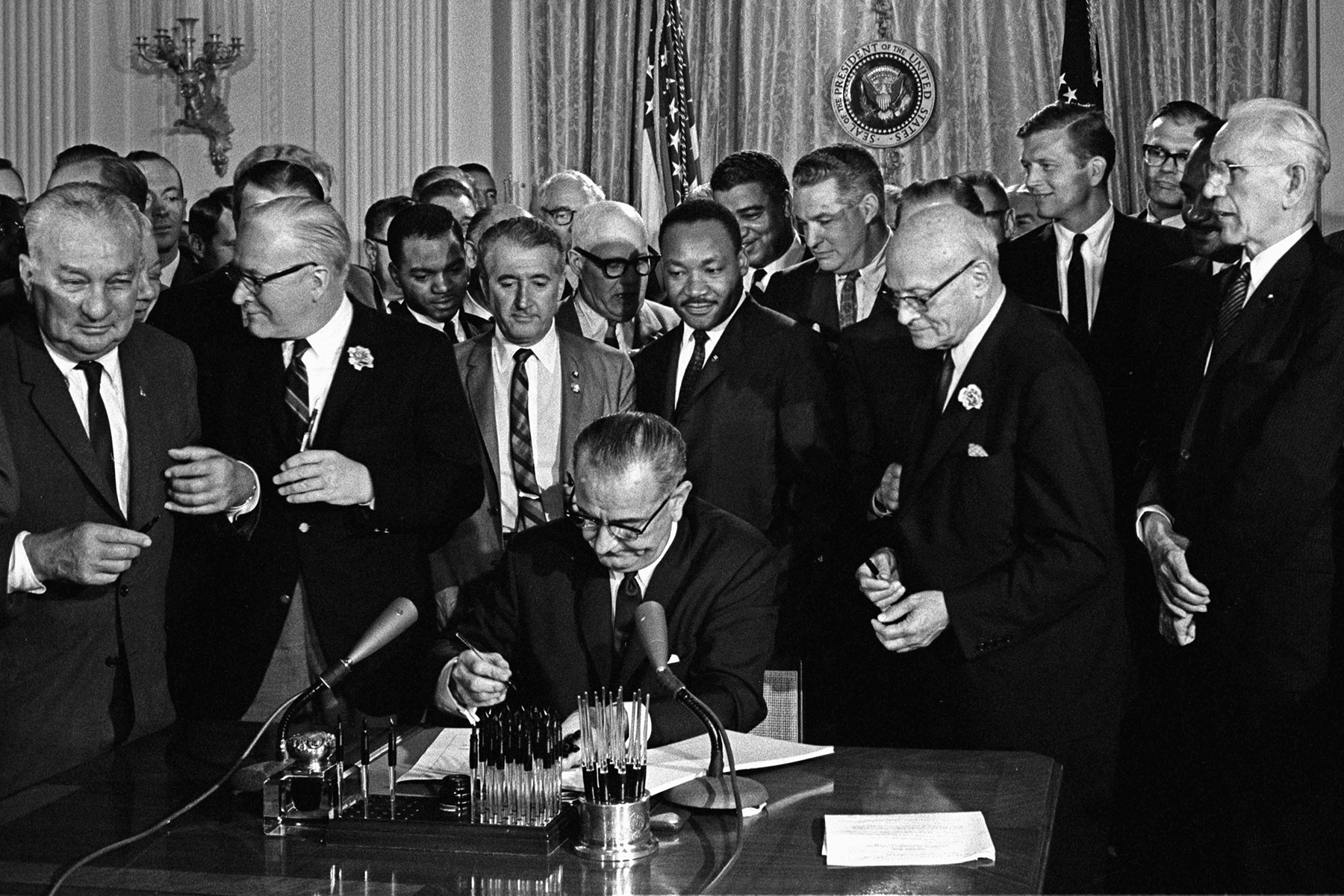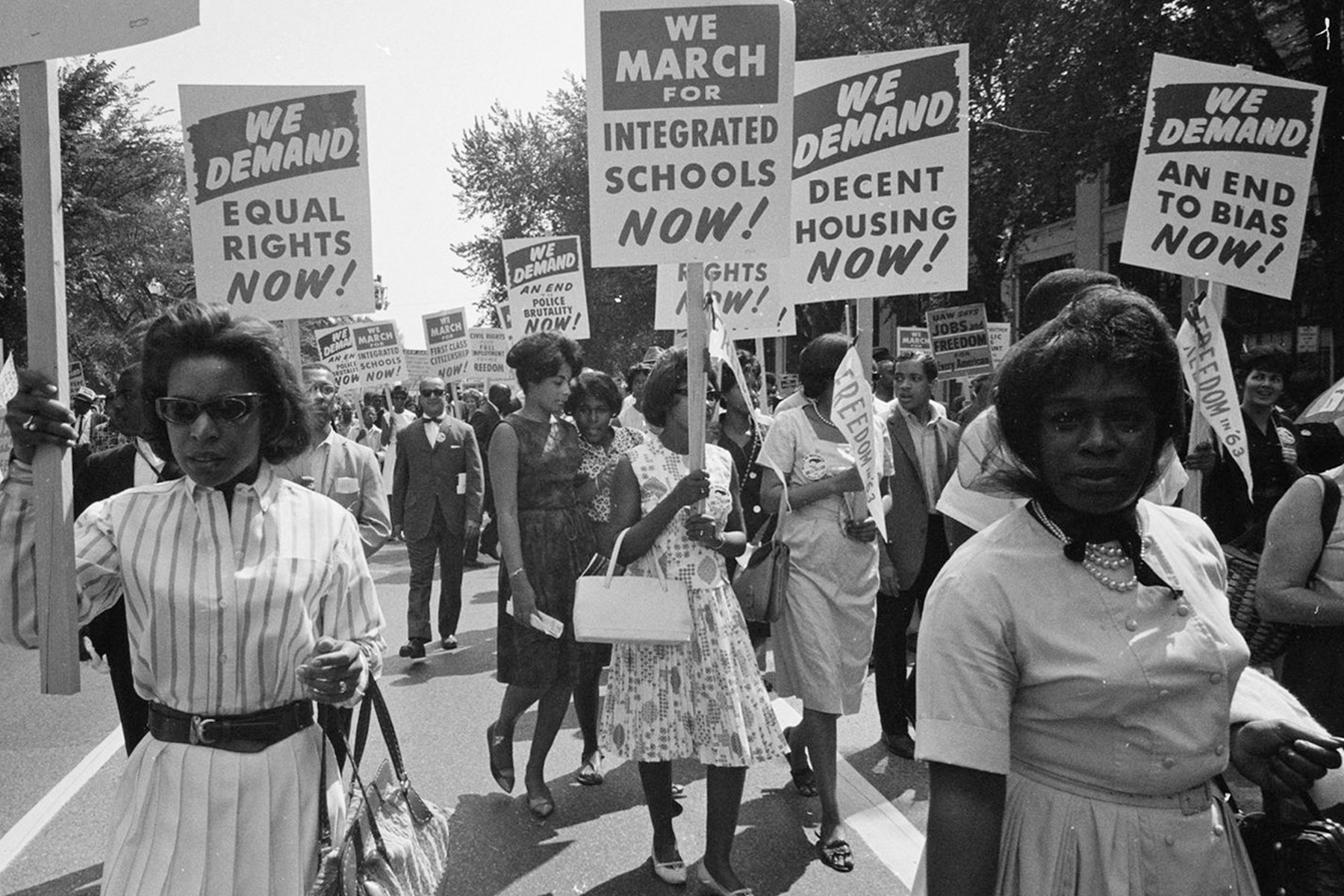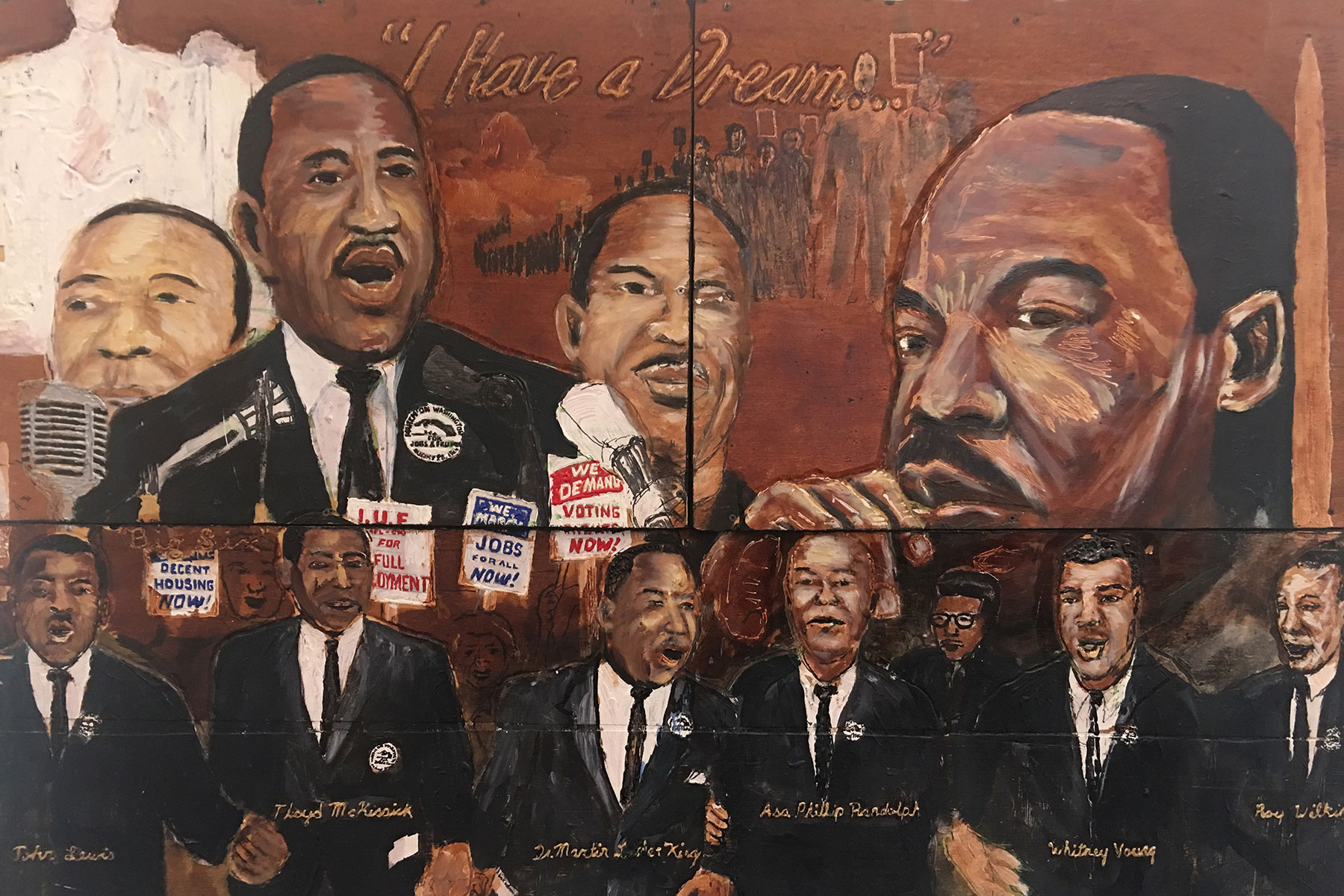
“If there is no struggle there is no progress. Those who profess to favor freedom and yet depreciate agitation, are men who want crops without plowing up the ground, they want rain without thunder and lightning. They want the ocean without the awful roar of its many waters… Power concedes nothing without a demand. It never did and it never will. Find out just what any people will quietly submit to and you have found out the exact measure of injustice and wrong which will be imposed upon them, and these will continue till they are resisted with either words or blows, or with both. The limits of tyrants are prescribed by the endurance of those whom they oppress.”
– Frederick Douglas August 3, 1857 speech in Canandaigua, New York
This year we are celebrating milestones. The 50th anniversary of the assassinations of Dr. King and Robert Kennedy will be commemorated in grand fashion. Programs celebrating the 50th anniversary of Milwaukee’s open housing marches and fair housing ordinance – which were designed to end housing discrimination – have been underway for months. Also a half century ago, Shirley Chishom became the first black woman elected to the House of Representatives and Arthur Ashe became the first black person to win the U.S. Open tennis championship in 1968.
However, there is one 50th anniversary that passed recently with very little fanfare. On February 29, 1968 the earth-shattering Kerner Commission report was released to public scrutiny. The official name of this 440 page report was “The Report of the National Advisory Commission on Civil Disorders.” President Lyndon Johnson commissioned the report in the wake of multiple large scale outbreaks of civil unrest around the country, the largest and deadliest being in Detroit, which ended with the deaths of forty-three people.
The most famous passage from the report states that, “our nation is moving toward two societies, one black, one white, separate and unequal.” Surprisingly, the report suggested that white racism was a cause of the unrest. The Commission surmised that white racism led to “pervasive discrimination in employment, education and housing.” They recommended an alternative course, “a commitment to national action — compassionate, massive, and sustained, backed by the resources of the most powerful and the richest nation on this earth. From every American it will require new attitudes, new understanding, and above all, new will.”
The report was summarily dismissed by many at the time, including President Johnson. Even years later there were those who were convinced the commission had it all wrong. In the wake of the election of President Barack Obama, just short of 41 years after the release of the report, the popular narrative concerning the Kerner Report was that the findings and predictions had been proven untrue. The people making these arguments apparently got swept up into the “color blind” and “we’ve come so far” conversations, which drove the national narrative in the wake of the election of the first non-white President in the America’s history.
My research over the past two years, looking at segregation as well experiencing the civil unrest in Milwaukee’s Sherman Park – just a few blocks from my home – show me very clearly that the conclusions of the report were in many ways very accurate. I am also more convinced than ever that a white backlash after the civil unrest of the late 1960’s, and a shift to conservative policies, is what prevented the recommendations from being carried out.
Most Americans are under the impression that the nation mourned Dr. King, when in fact many celebrated his death. He was a very unpopular figure at the time of his assassination. Dr. King had shifted his attention to speaking out against the massive economic inequality and poverty that he saw when he traveled to the ghettos of the North. What was even less popular, even among Civil Rights leaders, was his opposition to the war in Vietnam. He was roundly criticized in Op Eds around the country for taking a stand that was not directly related to the struggle for Civil Rights.
The most popular story about the failures to carry out the Commission’s recommendations, argue that the war in Vietnam prevented President Johnson and his administration from focusing on any other major issue. President Johnson was not a believer in the conclusions of the report and had no desire to follow the recommendations. In fact, the first draft of the report was much more damning than he anticipated. To his dismay, the report did not mention his Great Society programs as fundamentally contributing to the cause of poor blacks in a significant way. The President was so upset with the report that he refused to meet with the members of the commission after the report was released.
His public face differed from his private remarks, because he was concerned that if he publicly backed the report it would lessen the chances of the Democrats winning the election in the fall. Otto Kerner, Illinois Governor and Chairman of the Commission, said that privately the President supported their efforts and offered to assist. However, the president told Chicago Mayor Richard Daley the opposite in a secretly recorded phone call. Johnson believed that the Commission’s Vice Chairman, New York Mayo John Lindsay had pressured the Commission to be much more candid in its assessments than others wanted. “Well, I didn’t realize when I appointed Kerner that this son-of-a-bitch from New York, Lindsey, would take charge,” the President said according to Daley.
Dr. King said the report was “a physician’s warning of approaching death with a prescription for life.” Just as Frederick Douglas had done in 1857, Dr. King and Malcolm X both sounded the alarm about the danger to come if injustice suffered by blacks continued. King had warned us years earlier, during his famous March on Washington speech on August 28, 1963, when he said these prophetic words.
“It would be fatal for the nation to overlook the urgency of the moment. This sweltering summer of the Negro’s legitimate discontent will not pass until there is an invigorating autumn of freedom and equality. Nineteen sixty-three is not an end, but a beginning. And those who hope that the Negro needed to blow off steam and will now be content will have a rude awakening if the nation returns to business as usual. And there will be neither rest nor tranquility in America until the Negro is granted his citizenship rights. The whirlwinds of revolt will continue to shake the foundations of our nation until the bright day of justice emerges.”
Less than a year later, Malcolm X sent a warning about the threat of uprisings, due to the continuation of second-class status of blacks in America, during his famous “Ballot or the Bullet” speech on April 3, 1964.
“1964 threatens to be the most explosive year America has ever witnessed… Well, I am one who doesn’t believe in deluding myself. I’m not going to sit at your table and watch you eat, with nothing on my plate, and call myself a diner. Sitting at the table doesn’t make you a diner, unless you eat some of what’s on that plate. Being here in America doesn’t make you an American. Being born here in America doesn’t make you an American. Why, if birth made you American, you wouldn’t need any legislation; you wouldn’t need any amendments to the Constitution; I’m one of the 22 million black people who are the victims of Americanism. One of the 22 million black people who are the victims of democracy… I’m speaking as a victim of this American system. And I see America through the eyes of the victim. I don’t see any American dream; I see an American nightmare.”
On March 31, 1968, President Johnson shocked the nation by announcing he would “not seek and I will not accept the nomination of my party as your President.” Later that night he addressed the nation on television. “I think America will be a stronger nation, a more just society, a land of greater opportunity and fulfillment because of what we’ve all done together in these years of unparalleled achievement.”
Four days later, and just thirty-five days after the Kerner Commission Report was released, Dr. King was assassinated in Memphis leading to massive civil unrest in hundreds of cities around the country.
President Johnson’s remarks addressing the nation on March 31 were in stark contrast to the conclusions of the Kerner Commission. In fact, they contradicted the first words quoted in the report, those of President Johnson on June 27, 1967. These remarks were made just weeks before civil unrest broke out in Newark, New Jersey on July 12 and lasting through July 17, resulting in the deaths of twenty six people and millions of dollars in property damage. It was one of 159 instances of civil unrest during what has been called, “The Long Hot Summer of 1967.”
In his June address to the nation, the President said, “The only genuine long-range solution for what has happened lies in an attack-mounted at every level-upon the conditions that breed despair and violence. All of us know what those conditions are: ignorance, discrimination, slums, poverty, disease, not enough jobs. We should attack these conditions-not because we are frightened by conflict, but because we are fired by conscience. We should attack them because there simply is no other way to achieve a decent and orderly society in America.”
Richard Nixon won the 1968 presidential election in November, after running on a campaign which touted “law and order.” During a Q&A with the American Society of Newspaper Editors, Nixon said “there could not be order in a free society without progress, and there cannot be progress without order.” Nixon did not connect crime directly to the civil unrest, which drew praise from civil rights leaders at the time.
Despite this, it is clear by his policies and his shift in tone during the 1972 re-election campaign, that he was implying that the civil unrest was criminal in nature. Nixon took advantage of the negative racial beliefs of whites in what is known as his “Southern Strategy.” His efforts to convert white southerners to switch from the Democratic Party to vote Republican in 1972 by pandering to their racial animus towards blacks proved to be extremely effective. He won the South by landslides in each Southern state. “Crime and disorder” continued to be themes of both of Nixon’s presidential campaign wins.
With the anniversaries of these important milestones it is important to reflect back on the Kerner Commission report and look at where we stand now. Living in Milwaukee provides evidence of how far we still have to go.
Segregation and poverty have wreaked havoc on the black community of Milwaukee. One of the most salient, and controversial statements in the report spoke about the role of segregation and poverty in American society. The report stated, “Segregation and poverty have created in the racial ghetto a destructive environment totally unknown to most white Americans. What white Americans have never fully understood – but what the Negro can never forget – is that white society is deeply implicated in the ghetto. White institutions created it, white institutions maintain it, and white society condones it.” The report went on to say that “this deepening racial division is not inevitable. The movement apart can be reversed. Choice is still possible… to pursue our present course will involve the continuing polarization of the American community and ultimately the destruction of basic democratic values.”
There have been attempts to look at the progress we have made since the Kerner Commission Report was released. Both the 30th and now 50th anniversaries of the Kerner Commission Report have yielded studies examining the progress made. Unfortunately, each of these has sounded the same alarms. The first of these studies was “Locked in the Poorhouse: Cities, Race and Poverty in the United States.” This 1998 report stated that “the divide between rich and poor in the United States has become greater and the challenges from within more formidable.” Locked in the Poorhouse was composed of essays by experts who study where the nation is in regards to the issues the Kerner Commission Report spoke about.
A companion piece to “Locked in the Poorhouse” is titled “The Millennium Breech: Richer, Poorer, and Racially Apart.” That report pointed to the progress made since 1968. The expansion of the black middle class achieved by the civil rights movement, and the millions who converted their energy and activism into positive change is celebrated. The report also articulates the rise in the number of black businesses and elected officials as well as higher graduation rates among blacks as obvious signs of positive change.
They also look at the changing economy and technology advancements as obstacles to black progress. The low skill jobs that many blacks have depended on since the 1950s are going away, being replaced by high tech jobs requiring advanced education. “The Millennium Breech” report discussed and dissected the “jobs gap.” Professor William Julius Wilson of the Kennedy School of Government is quoted in the report. He says, “The exodus of working and middle-class blacks from core inner-city neighborhoods enhanced the concentration effects of joblessness and poverty and removed important economic and social buffers that had softened the impact of macroeconomic changes in these vulnerable communities. During the decades of the 1970’s and 1980’s, conditions in inner-city ghettos went from bad to worse.” The report goes on to say, “The consequences of neighborhood joblessness are more devastating than those of high neighborhood poverty.”
Locally, Professor Mark Levine of the University Wisconsin Milwaukee’s Center for Economic Development (UWM-CED) has studied both poverty and joblessness as it relates to blacks in Milwaukee. His team’s research paints a stark picture; showing just how accurate Wilson and Marshall were in 1998. In a 2003 report titled “Stealth Depression: Joblessness in the City of Milwaukee Since 1990,” Levine found stark disparities in the economy of Milwaukee.
The executive summary of the report stated the following. “The economic boom of the 1990s has already become a distant memory for Milwaukee’s labor market. Through most of the 1990s, the unemployment rate for city residents ran below or close to the national average for the nation’s 50 largest cities. Today, at 9.3 percent, Milwaukee’s unemployment rate is over two percentage points higher than the national ‘big city” average, and significantly higher than the 5.7 percent unemployment rate at which it began the 1990s… In Milwaukee’s inner city, joblessness is endemic. 56.4 percent of working age males in the city’s “Enterprise Community” – census tracts designated as the “inner city” by City Hall — were either unemployed or not in the labor force. By 2000, in almost one-third of the census tracts in the city of Milwaukee, over half the working age male population was unemployed or not in the labor force.”
Just as the Kerner Commission Report called for comprehensive policy changes, Levine’s report stated the same needs. “The “stealth depression” in the city of Milwaukee’s labor market calls for bold, new departures in public policy. Initiatives in public investment, regional cooperation, reducing metro-wide racial segregation, industrial policy, and community benefits agreements should be considered as part of an aggressive anti-unemployment strategy in the city.”
None of the bold initiatives suggested took place. The loss of manufacturing jobs, family supporting wages and guaranteed retirement benefits has been a deadly poison of distress in the black community in Milwaukee. The UWM-CED data has tracked the loss of manufacturing jobs and the subsequent growth of concentrated poverty which resulted from it. An extensive study conducted by the Milwaukee Journal Sentinel in 2004 called “A Dreamed Derailed” showed the extent of the 180° shift in opportunities for black Milwaukeeans. A follow-up story in 2017 entitled “50-Year Ache: How Far Has Milwaukee Come Since the 1967 Civil Rights Marches” provides further proof that many things have not changed and some have become progressively worse.
Most of the information about the backsliding of opportunities for blacks has been lost in translation. Despite ample evidence to the contrary, most conversations regarding the state of blacks here in Milwaukee and across the nation, centers on what Daniel Patrick Moynihan derisively described as the black “culture of poverty.” This argument achieved the distinction of being just the excuse America needed to take the pressure off of racism as the central cause of the wretched condition blacks lived under. This theory pointed the finger of blame at the so-called culture of blacks as the cause for all if not most of their problems. According to the theory, black cultural practices have kept blacks in a perpetual state of poverty, despite government largesse and the work of liberal whites who tried so hard to “lift blacks up” from their deplorable conditions.
Moynihan used the classic blaming the victim approach, which had always proven its effectiveness in the past. By blaming black “cultural deviance,” whites could no longer be held responsible. In his position of Assistant to the President for Domestic Policy, Moynihan was in the perfect place to craft the strategies President Nixon utilized to begin de-valuing social safety net programs. These new policies were in stark contrast to Lyndon Johnson’s Great Society programs. The Great Society programs were designed to help black central city residents who had escaped Jim Crow South only to encounter Jim Crow North.
Quietly as progress was beginning to be made by blacks in education and the workforce, plans were being put into place to slow down and even derail this progress. No longer could blacks look to the Federal government as their friend. The FBI with its nefarious COINTELPRO program under the leadership of J. Edgar Hoover had infiltrated and progressively destroyed the ability of every major black civil rights organization to continue to be effective.
The Federal Fair Housing Act of 1968 was rushed through Congress and signed into law just a week after Dr. King’s assassination as a mechanism to quell violence that had erupted around the country. On April 11, the nation will honor the anniversary of this law. We have been taught that this law was a monumental shift in housing policy after decades of intentional government sanctioned discrimination against blacks, Latinos, Asians and Native Americans across the country. The Milwaukee Common Council, feeling similar pressure, finally passed a local fair housing ordinance just a short time later.
The 200 consecutive days of protesting housing discrimination in Milwaukee in 1967-68 led to a massive change in the housing patterns of the city. No longer would blatant discrimination be acceptable under the law. Notwithstanding this brilliant and brave campaign against segregated housing, things had not changed much on the south side of Milwaukee. A special census conducted in 1975 highlighted the lack of progress in negating residential segregation on the other side of 16th St. viaduct.
The shift in where blacks moved after the new ordinance passed was to the north and the west sides of town, not to the south side of the city. A majority of white neighborhoods across the bridge still had single digit numbers of black residents eight years after the marches and open housing ordinance. Clearly, a change in the law was not enough.
The Kerner Commission predicted what would happen without intervention by federal, state, and local governments. During the 1990’s it appeared that the Commission was wrong. The economy was growing at a pace unseen in decades, unemployment was low and black incomes were on the rise. The recessions of the early 2000’s, and the bursting of the so-called “dotcom bubble” slowed down the progress but the black homeownership rates were still increasing. In 2008, President Obama’s election appeared to be the pinnacle of success over the ugly days of the flagrant discrimination of the past. As President, Obama promised change and many blacks celebrated by singing “We Have Overcome.”
The election of President Obama, many said, was a realization of Dr. King’s famous dream. I believe we were walking around with a false sense of accomplishment. Obama won just over 42 percent of the white vote in 2008 and only 39 percent in 2012, according to exit polls. For many blacks the dream was morphing into a nightmare. The nation continued to be chameleon-like. On the surface, this new “colorblind” society appeared to usher in the era of a “post-racial” America. Scratching just below the surface would uncover the harsh truth.
Laws had changed; racial attitudes as expressed in national polling data had changed for the better also. But an analysis of the real world showed a different reality for a majority of blacks. Affirmative action laws and policies, which had been effective in opening doors for blacks, were being overturned around the nation. Our schools were becoming increasingly more segregated as consent decrees demanding desegregation, were being reversed in the courts. Funding for public schools was being cut, with big city majority black school districts suffering the most.
Police brutality had become much more visible due to camera phones and social media. Hate groups had seen a resurgence after the election of President Obama. They were growing in size, influence, and acceptability. A massive number of black men and women were incarcerated, black child poverty was growing at an alarming rate, and high-quality, family supporting jobs were now becoming out of reach for many blacks, despite them having higher levels of education.
The 2000’s and 2010’s would be decades of change. Manufacturing plants which fled the city had a huge impact on black Milwaukee. National, state, and local government civil-service jobs have also been lost in large numbers. In many respects those jobs were the means of escaping the abyss of concentrated poverty for blacks in Milwaukee. Poverty was becoming more prevalent and was spreading like wildfire in Milwaukee. The gains of the previous 50 years were being reversed before our eyes.
Young people, who have been constantly told that “getting your education” was the key to success, have become increasingly disenchanted with what they witness. A high school education, which was the ticket to progress in blue collar work, had lost out to the need to have a college degree to attain a measure of economic success. The jobs of the future will become scarcer for those without a college degree. The increasingly astronomical cost of college is leaving many discouraged or in tremendous debt.
This new economy is not offering the same level of opportunity to achieve the American dream. Real wages have been dropping as adjusted for inflation over decades for all Americans. Income and wealth inequality is becoming more pronounced. Making the current minimum wage of just $7.25 per hour, guarantees a life of poverty. Those working a full-time minimum wage job, 40 hours per week for a full year, will make only $15,080 in a year before taxes.
Economic insecurity was worsened by the rise in anti-black rhetoric caused by the backlash to the Black Lives Matter campaign. Presidential candidate Donald Trump used coded, dog-whistle language to express the views of whites who pined for the “good old days.” His “Make America Great Again” slogan reminded blacks that what is great for America has never necessarily been great for black people.
The rise in hate groups, which occurred as a reaction to the Obama Presidency, spiked once again during the Trump Presidential campaign. Openly white supremacist groups no longer saw the need to remain undercover. The so-called Alt-Right movement, is a clear manifestation of a longing by many whites for the days when whites did not have to question the supremacy of the position they occupied in America.
Loudly articulating the ideals of white supremacy became mainstream again in the age of Trump. After a devout white supremacist drove his vehicle into a crowd, striking dozens and killing a young woman in Charlottesville, the President refused to call it hate. In fact, he went so far as to compare white supremacists to those protesting white supremacists, by saying they were good people on both sides. Despite the outrage, his base continues to support the President.
We must practice caution in this year of celebrations and commemorations. It is easy to look back at how horrific things were in 1968 and speak to the progress made. We cannot be tricked into looking at the progress through one eye and close the other so that we are unable to see the continuing struggles. Remember that many of the commemorations during this year are of horrible events from 1968. Assassinations of public figures; police violence at the 1968 Democratic Convention in Chicago, and massive unrest around the country were precursors to the end of the Civil Rights Movement as a force in America.
A recently released report by the Economic Policy Institute called “50 Years After the Kerner Commission” details the lack of progress in multiple areas. The report looks at key indicators which show us that “in several important respects, African Americans have actually lost ground to whites.” There has been progress, but it has been limited. Some of the findings are related to educational attainment. “More than 90 percent of younger African Americans (ages 25-29) have graduated from high school, compared with just over half in 1968.” This same group is also “more than twice as likely to have a college degree as in 1968 but are still half as likely as young whites to have a college degree.” So obviously the call to “get your education” has been heeded by young blacks.
Despite these major shifts and other improvements in wage earnings, wealth and health outcomes, blacks still trail whites economically. Blacks are 2.5 times more likely to live in poverty as whites according to the report. The black unemployment rate, currently at 7.5 percent is higher than the 6.8 percent fifty years ago. Black homeownership at “just over 40 percent” is practically the same as in 1968 and trails “a full 30 points behind the white” rate.
The single greatest change in the lives of blacks is incarceration. “The share of African Americans in prison or jail almost tripled between 1968 and 2016 and is currently more than six times the white incarceration rate” nationwide. Wisconsin has the second highest black incarceration rate overall if women are included. The rate for black males in Wisconsin is the highest in the nation.
April 4 is the 50th anniversary of the assassination of the Reverend Dr. Martin Luther King Jr. That date was a turning point in the history of the tumultuous decade of the 1960’s. America was never the same again. Dr. King is celebrated today as a heroic figure in the history of the struggle for Civil Rights for all Americans. His death was a watershed moment in that movement. Contrary to the now popular narrative about Dr. King, he was seen at the end of his life in a much more negative light.
The FBI’s COINTELPRO program records paint a picture of FBI Director J. Edgar Hoover as having a strong desire to destroy Dr. King’s reputation and lessen his power as a national and worldwide leader. Hoover saw Dr. King as an enemy of the state and called him “the most notorious liar in the country.” Dr. King’s change of course in his later years, to address poverty and war, led many of his supporters to turn away from him openly. In 1967 he said these words about the war in Vietnam.
“As I have walked among the desperate, rejected, and angry young men, I have told them that Molotov cocktails and rifles would not solve their problems. I have tried to offer them my deepest compassion while maintaining my conviction that social change comes most meaningfully through nonviolent action. But they asked, and rightly so, ‘What about Vietnam?’ They asked if our own nation wasn’t using massive doses of violence to solve its problems, to bring about the changes it wanted…Their questions hit home, and I knew that I could never again raise my voice against the violence of the oppressed in the ghettos without having first spoken clearly to the greatest purveyor of violence in the world today: my own government.”
Dr. King’s shift to criticize the nation for bringing violence to Vietnam was echoed in statements he made about how this would leave gaps in funding to help poor black and brown communities here in the United States. Obviously, the war took a toll on President Johnson. As our national infrastructure was falling apart in big cities across the country, massive funding was diverted to fight the war in Vietnam. Those who had demanded change at home would be drowned out.
Frederick Douglass warned us in 1857 that power concedes nothing without a struggle. Those words have as much meaning today as they did when Douglas spoke them. We must be aware and cognizant of the need to continue to struggle. We must never lose faith. We must never lose passion. We must never lose the belief that we have the ability to make positive change occur. It is incumbent upon all of us to make this happen. Those who profess to want America to live up to the ideals of the Founding Fathers must continue to challenge the status quo. We must demand an extension of equality of opportunity to all Americans.
We can no longer afford to sit back and watch as Native Americans fall into a further chasm of despair. The growth of poverty and homelessness across many racial and ethnic groups must be seen as a common thread. Divisions which have been sown by this current administration must be seen for what they are, a distraction. What many whites are crying out against are conditions that people of color are intimately familiar with. This has been our lived experience for most of the nation’s history. We’ve warned whites that it’s just a matter of time before it catches up to them.
Let us not have a story written 50 years from now looking back on this time as a time of acceptance, where America had the opportunity to face up to its ongoing problems with race by facing them directly and working on them with a true desire to improve the life conditions for us all and instead did nothing meaningful. If that is what happens, I fear for the future of our children. I fear that the efforts of today as well as the efforts leading up to the Civil Rights Movement will have been in vain.
As we look back on these anniversaries, let us be aware of what the Kerner Commission report warned us about. We should take heed to the recommendations they made. Let us not continue to make the same mistakes time after time again. It is time we wake up and see America with clarity and without bias.
Let us not be naïve and tricked into seeing progress without measuring it against where we should be. The struggles of the past are designed to push us towards a new world with more equity and less disparity. That is not what the record shows we’ve achieved for many. Those who have found success in America must not look down upon those who’ve been left behind and point the finger of blame.
The famous words of the Declaration of Independence stated. “We hold these truths to be self-evident, that all men are created equal, that they are endowed by their Creator with certain unalienable rights, that among these are Life, Liberty and the pursuit of Happiness. That to secure these rights, governments are instituted among men, deriving their just powers from the consent of the governed.” According to how I interpret these words, the duties of our government are intertwined with providing these rights under the consent granted them by the citizens of our nation.
Those who speak of the role of government being smaller, of so-called government handouts and largesse have clearly not read the Declaration of Independence. The government that was created was designed to help Americans to secure the rights of life, liberty and the pursuit of happiness. Let us not lose sight of this. Our struggle will not end until we live up to these lofty goals. We should create a nation which knocks down those barriers which limit progress.




![Dominic Inouye: On Discovering the [Real] Heart of Milwaukee](https://www.milwaukeeindependent.com/wp-content/uploads/2018/12/00_121518_RealHeartMKE_001-440x264.jpg)












